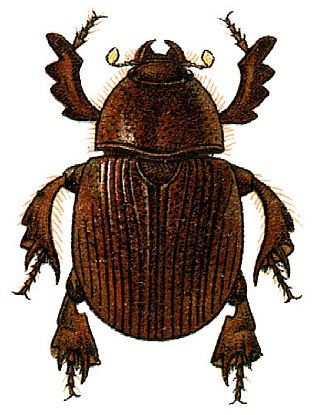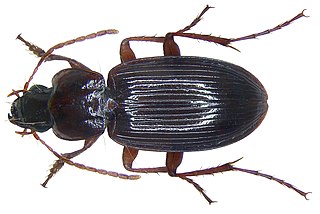Mogrus is a genus of jumping spiders that was first described by Eugène Louis Simon in 1882.

Agonum is a large genus of ground beetles in the subfamily Harpalinae, tribe Platynini. They are mid-sized to smallish beetles, typically with dark metallic hues – often reddish or bronze, but sometimes black, green etc.

Dynamopodinae is a very small subfamily of Scarabaeidae or scarab beetles, with only seven species in a two genera.

Badister is a genus of ground beetle in the family Carabidae native to North Africa, the Near East, and the Holarctic, including Europe.

Cymindis is a genus of ground beetle native to the Palearctic, the Near East, and North Africa. It contains the following species:

Poecilus is a genus of ground beetle native to the Afro-tropical, the Palearctic, the Near East, North Africa, and North America regions.

Galeodes is a genus of solifuges or sun spiders. The nearly 200 species in this genus are found in northern Africa, southeastern Europe and Asia. Like other solifuges, they are mainly nocturnal and found in arid habitats. They often have long hairy appendages and are not as stout bodied or dark and contrastingly coloured as some other solifuges. Some Galeodes species are able to produce sounds by stridulation. These are usually raspy or hiss-like and may be imitations of the sounds of vipers, to serve a defensive function. As in other solifuges, mating involves the male depositing a spermatogonia that is manipulated into the female genital opening using their chelicera. The male strokes the female using the palps allowing her to be approached. Females will often feed on males before or after mating. The female then deposits the eggs in a burrow in soil and in some species guards them.
Mesolestes is a genus in the beetle family Carabidae. There are more than 40 described species in Mesolestes.
Apristus is a genus of beetles in the family Carabidae, containing the following species:

Lionychus is a genus in the ground beetle family Carabidae. There are at least 20 described species in Lionychus.

Syntomus is a genus in the beetle family Carabidae. There are at least 50 described species in Syntomus.
Singilis is a genus of beetles in the family Carabidae, first described by Jules Pierre Rambur in 1837.

Platynus is a genus of ground beetles in the family Carabidae. There are more than 180 described species in Platynus.

Platyderus is a genus of ground beetles in the family Carabidae. There are more than 100 described species in Platyderus.
Pseudotaphoxenus is a genus of ground beetles in the family Carabidae. There are more than 110 described species in Pseudotaphoxenus, found in temperate Asia.
Taphoxenus is a genus of ground beetles in the family Carabidae. There are about 14 described species in Taphoxenus.

Pogonus is a genus of ground beetles in the family Carabidae, found worldwide. There are more than 50 described species in Pogonus.

Lebiini is a tribe of ground beetles in the family Carabidae. There are more than 250 genera and 4,800 described species in Lebiini.
Cymbionotum is a genus of ground beetles in the family Carabidae. There are at least 20 described species in Cymbionotum.











